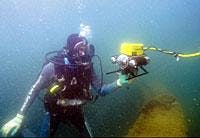Gulf of Mexico
Jennifer Pallanich Hull, Houston
Sale 184 to feature royalty initiatives
Taking a look back at the last few lease sales in the Gulf of Mexico, it appears initiatives have prompted companies to focus on areas offering royalty relief.
"They're paying attention to some of those initiatives," Barney Congdon, Minerals Management Service spokesman, said.
The 22.2 million acres up for bid in Western Gulf of Mexico Lease Sale 184, set for Aug. 21, will likely draw interest from those seeking the incentives. The MMS's sale has initiatives to increase domestic natural gas and oil production to meet US energy needs.
Under the shallow-water, deep-gas incentive, royalty will be suspended on the first 20 bcf of production from a well drilled below 15,000 ft. There are 1,642 blocks subject to this initiative. Also, deepwater royalty relief will be applied to leases in water depths exceeding 400 m. The specific terms for royalty relief will be granted to individual leases, not fields, as in the Deep Water Royalty Relief Act of 1995, and will be designated at the time of the final notice of sale, which was set for early July.
"That's when you can start to really evaluate what sort of activity is going to surround this lease sale," Congdon said.
Under the proposed sale notice, royalty suspension volumes that lessees are allowed to produce before royalty obligations become due to the US government are:
- 5 MMboe in water depths of 400-799 m, 372 blocks offered
- 9 MMboe in water depths of 800-1,599 m, 1,030 blocks offered
- 12 MMboe in depths greater than 1,600 m, 845 blocks offered.
There are 196 blocks with no automatic royalty relief. Previous deepwater relief given for new leases under DWRR Act of 1995 has expired.
Sale 184 is expected to include 4,085 unleased blocks in the Western GOM outer continental shelf (OCS) planning area offshore Texas and Louisiana. The blocks are located from 9 to 250 mi offshore in water depths ranging from 8 m to more than 3,000 m. The MMS estimates undiscovered economically recoverable hydrocarbons expected to be discovered and produced as a result of this sale range from 10 MMbbl to 90 MMbbl and 570 bcf to 1.93 tcf of natural gas. There are 1,875 blocks in water depths of 800 m or more.
The last sale with a western focus, Sale 180 in August 2001, drew $165.6 million in high bids. Of the 4,114 tracts offered, 50 companies bid on 320 blocks. The MMS ranked Sale 180 as the fourth most successful western sale in the decade, based on number of tracts receiving bids.
The MMS also expects OCS daily oil and gas production rates through 2006 to increase to between 2 MMb/d and 2.47 MMb/d. Gas output is expect to reach 10.97 bcf/d to 16.39 bcf/d, the MMS said.
MMS Director Johnnie Burton called the new projections "a healthy, sizeable increase in the range of possible oil production. Should the high case estimates be reached in 2006, we will see a 160% increase in oil production from the Gulf in the period 1995-2006."
Oil production in the GoM was 945,000 b/d in 1995. Gulf oil output was estimated at 1.5 MMb/d in 2001, and Gulf deepwater oil production surpassed shallow-water oil production in March 2000. According to these forecasts, as much as 77% of daily oil production in the Gulf and 26% of daily gas production could come from the deepwater Gulf of Mexico by 2006.
VideoRay studies GoM platforms
The VideoRay micro ROV sent back underwater video of the Gulf of Mexico and took samples in the Gulf's deep and silty waters.
Mark Miller, a researcher at the Louisiana State University's Coastal Studies Institute, used the VideoRay to study the marine life that lives and thrives on the legs of oil and gas platforms in the GoM. The ROV, the size of a boot box, explored inside the USS Arizona battleship during a previous project.
Miller said he blends biology and geology to help companies better understand what factors influence the environment around platforms.
He studied several abandoned oil and gas platforms and the largest artificial reef in the world to remove samples and observe barnacles, coral, and algae. Miller also performed a holistic survey of the natural reef shelf off Louisiana in 220 ft of water. Miller used the VideoRay's sonar capability to map the area and associate fish with the structure. He hopes the 24 hours of deepwater video he collected with the VideoRay will help answer questions about what attracts and sustains the marine life on the legs.
"The portability of the VideoRay allows me to complete my objectives with less manpower and smaller vessels of opportunity that are less expensive," Miller says.
Cascade up for more drilling
BHP Billiton's Cascade exploratory well in the ultra-deepwater Gulf of Mexico has encountered an encouraging hydrocarbon column, the company said. The Cascade No. 1 well in Walker Ridge block 206, drilled by drillship C.R. Luigs, will likely be followed by further drilling to determine the size of the find. The prospect, in 8,200-ft water depth, is 50%-held by BHP, with Petrobras and Devon Energy Corp. each holding 25%.
Devon said it recently drilled four operated natural gas wells in the West Cameron area of the GoM based on 4C seismic results. The two wells on West Cameron blocks 534 and 536, where Devon has a 100% working interest, have a combined initial gross natural gas production of 36 MMcf/d.
The two wells on West Cameron block 532, where Devon has a 67% working interest, have combined initial gross production of 30 MMcf/d. Newfield Exploration Co. holds the remaining 33% working interest in the wells on block 532.
"Four-component seismic is proving to be a useful risk-reducing tool in the Gulf," said J. Michael Lacey, Devon's senior vice president for E&P.
null


